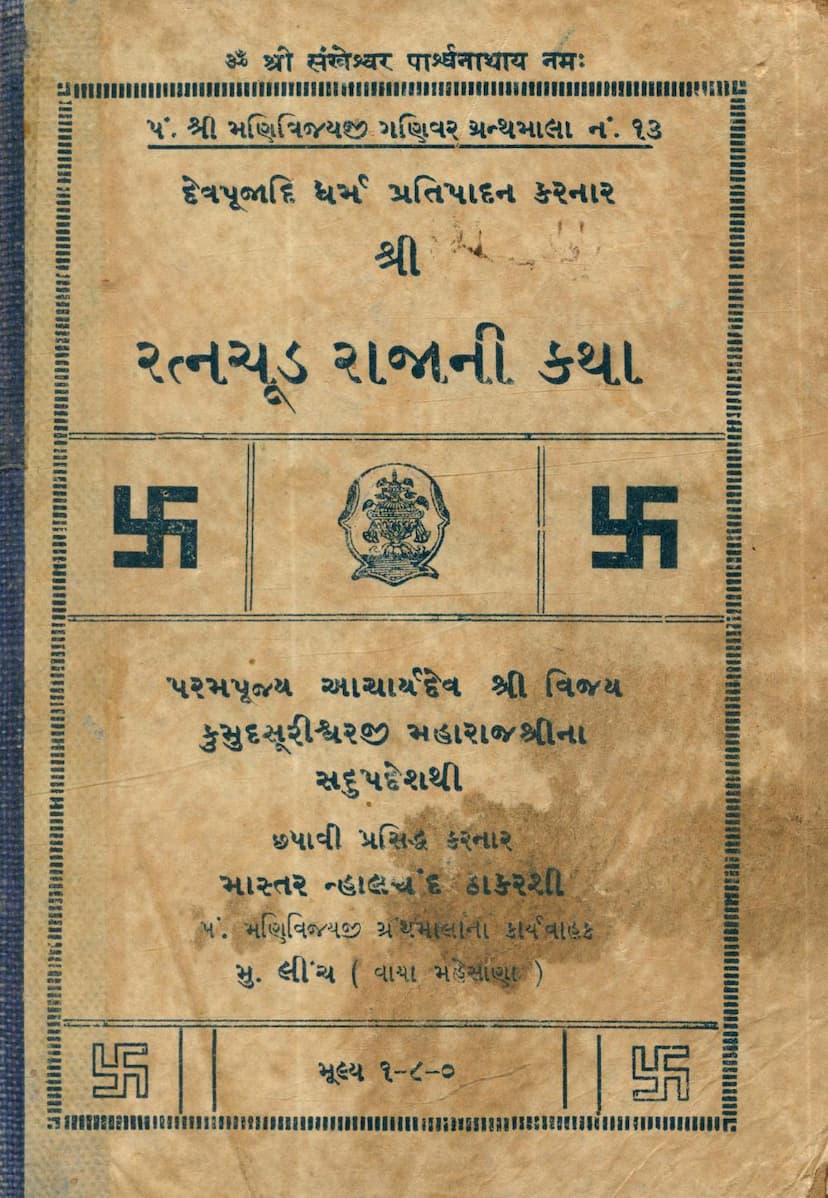Ratnachud Rajani Katha
Added to library: September 2, 2025

Summary
"Ratnachud Rajani Katha" (The Story of King Ratnachud) is a Jain text published by Manivijay Granthmala, identified as their 13th publication focused on "Devapujadi Dharma Pratipadan Karnar" (establishing the religion of idol worship etc.). The book is presented as a Gujarati translation of an original Prakrit text composed in the 12th century by Upadhayay Nemichandrasurishwarji, for the benefit of "bhavya jiva" (virtuous souls).
The core theme of the story revolves around the importance of Devapuja (worship of deities) and Samyaktva (right faith/belief), emphasizing that worship performed with devotion leads to profound self-development. This is illustrated through the story of Bakul Mali (Bakul the gardener) and his wife Padmani from Kanchannagar in the Kaling country.
The narrative highlights the following key aspects:
- The Encounter at the Festival: During a grand festival celebrating the first Tirthankar, Shri Rishabhdev Swami, Bakul and Padmani, after selling their flower garlands, decided to visit the temple.
- Bakul's Devotion: Upon seeing the idol of Adinath Prabhu, Bakul's mind became serene. He reflected on the blissful experience of seeing the Lord and the prosperity it brought to others. Though humble, he wished to offer his unsold flower garland. He then resolved to offer one lakh flowers from his garden to the Lord daily for a month, believing this would help him escape the cycle of suffering in this world.
- Padmani's Shared Devotion: Padmani shared this aspiration, and together they offered the best garland from their basket to the Lord, making a vow to offer one lakh flowers for a month.
- The Fruits of Devotion: This act of devotion, performed with a pure heart and increasing enthusiasm, led them to accumulate immense merit (punyanubandhi punya). They enjoyed a human lifespan filled with prosperity, a loving family, and wealth. Their devotion became a stable part of their lives.
- Rebirth and Kingdom: Bakul's soul was reborn as King Kanaksen's son Tilak Sundari in Gajpur city. Their devotion led to their spiritual development, making them just, generous, courageous, and noble from birth.
- The Power of Devotion: The text emphasizes that by recognizing the virtues of the Lord and serving Him with sincere effort according to one's capacity, one can overcome accumulated karmas, purify the soul, attain worldly glory, and eventually liberation (moksha).
- The King's Journey: The story extends to King Ratnachud himself, who attained Samyaktva through the guidance of the ascetic Muni Suraprabha. He married five virtuous princesses, who helped him and their parents embrace Jainism. Ratnachud's righteous rule, supported by knowledge of various arts and sciences, allowed him to travel and visit holy places, benefiting many and guiding them towards Jainism. Due to karmic obstacles, he couldn't take full asceticism but diligently observed vows. Ultimately, he was reborn as Achyutendra in the twelfth heaven, and after exhausting his merits, became a Chakravarti king in Mahavideh, eventually attaining eternal liberation.
The book includes various other stories and teachings related to Jain principles, such as:
- The story of Kshemankar the goldsmith.
- Previous lives of Shantinath.
- The owl story.
- The Yaksha story.
- Stories about generosity, reverence for the divine, and the importance of chastity (shil).
The text also underscores that the Panch Namaskar mantra is the ultimate cause for all these beneficial religious practices, comparing it to a wish-fulfilling gem and a wish-fulfilling tree, a ship to cross the ocean of existence, and a mantra to destroy suffering and afflictions.
The "Ratnachud Rajani Katha" serves as a didactic narrative to inspire readers towards spiritual purification and devotion, highlighting the transformative power of worshipping the Jinas and following the Jain path. The publisher, Manivijay Granthmala, thanks the Jain communities of Kherwa and Kadi for their financial contributions towards the printing of this book.